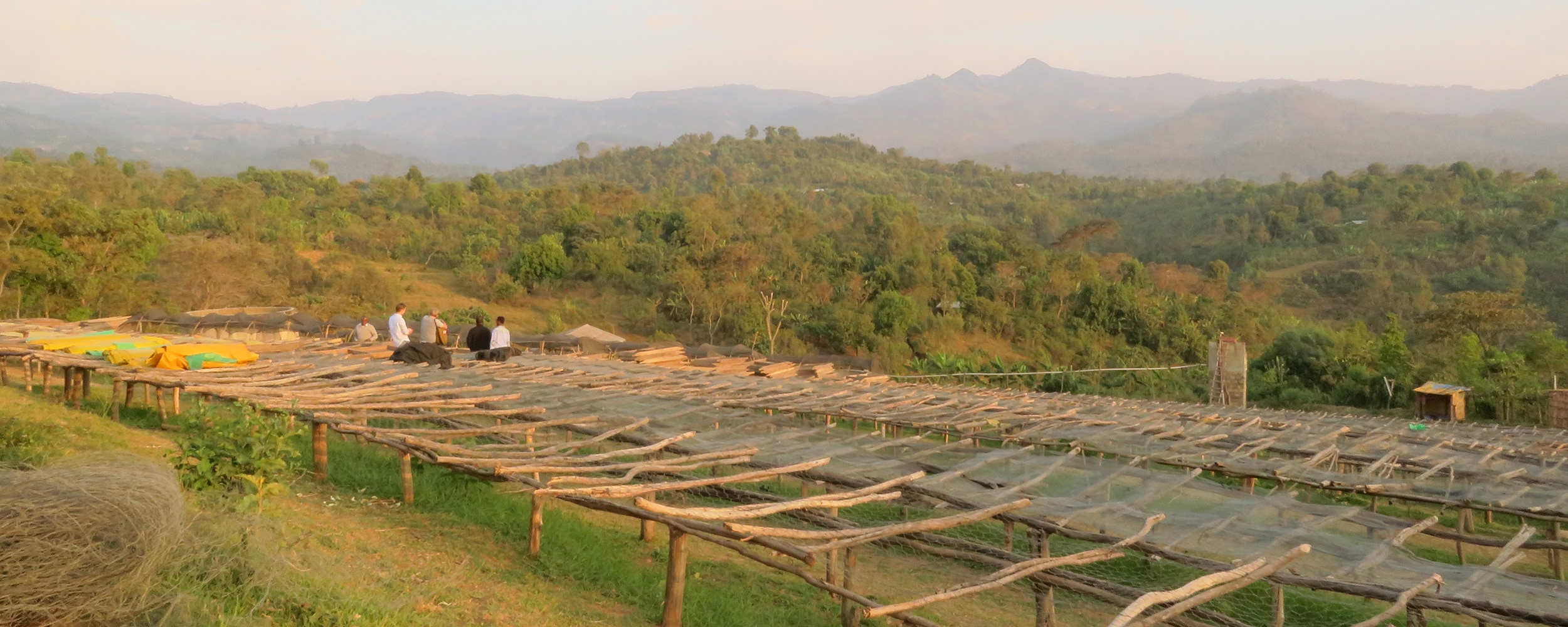There are many players and logistics to understand when sourcing Ethiopian coffee, but what usually fascinates drinkers and baristas about Ethiopian coffee is the fact that Ethiopia is the true origin of coffee. It is the place where coffee was discovered growing naturally. In addition, the coffee from Ethiopia is unique in flavor – some would even say unparalleled. The methods for farming and processing Ethiopian coffee are also unique.
To start, let’s breakdown the geographical and linguistic challenges of establishing just what and where those Ethiopian beans come from.
Since 1996, Ethiopia has been divided into 9 autonomous regional states, which are largely based on ethnicity. The labels are traditional and not typically used to label coffee.
Zones
Of these 9 autonomous states, Ethiopia is divided into 86 smaller zones. Many of these are used when labelling coffee. Some that you’ve likely heard or read: Sidama, Guji, Gedeo. Zones are similar in size to the small New England States.
Woreda
Within each zone are small municipalities, called woredas. These are similar to counties and can contain multiple cities. These are also often used to label coffee: Yirgacheffe, Hambela, Kochere, Gedeb, Shakiso. To make matters even
more confusing, each of these Woreda’s also have a taste profile established by the ECX, so in the past few years it is possible to grow a coffee in Gedeb, but have it sold as Kochere on the ECX because of its attributes. Washing stations have not been too against this in the past because certain woreda’s, like Kochere, fetch a higher price when sold through the ECX.
Kabeles
Each woreda is also divided into small neighborhoods called kabeles. These are quite small and often surround a city of the same name. Washing stations and cooperatives will often buy coffee from several surrounding kabeles. Up until this year, the kabele was not something associated with the coffee when sold at auction at the ECX, so many washing stations still do not divide their lots by kabeles, while some do.
Washing stations
Washing stations are really the critical point for coffee quality and traceability. With the changes to ECX this year allowing buyers to know which washing station lots are from before buying, the reputation of these stations is surely going to become quite important. Privately-owned washing stations are spread throughout the coffee growing zones of Ethiopia. Their number is increasing as laws have relaxed in the last two years, allowing washing stations and large farms to export their own coffee. The result has been that many
exporters are buying or building new washing stations so they can collect cherries for themselves instead of having to buy from privately owned washing stations.
Washing stations are very busy places during the harvest season (November – January). Each day, the stations will collect cherry throughout the day from neighboring farmers, independent buyers who seek out farmers themselves, or collection routes. At the end of each day, the cherries are loaded into a large concrete hopper where they are usually floated in water to remove the obvious floaters. The cherries are then depulped. Most farms in Ethiopia use disc depulpers and require a large amount of spring fed or river water. Newer farms and co-ops are using Penagos Ecopulpers, which greatly reduce the need for fresh water.
After depulping, the seeds, still covered in parchment and sticky mucilage, are put into a concrete tank and covered with water. Over a period of 32-60 hours (as little as 8 hours with eco-pulpers), the mucilage is consumed by natural yeast and microorganisms in the air. After the holding period has come
to an end, the seeds are released into a concrete channel, where water is passed over them and they are raked against the current.
This cleans the seeds of all the mucilage. The process can take up to an hour and is sometimes done in unison by a team who will synchronize their timing with song.
The washed coffee is then set out in the sun on raised beds to dry. This period takes as little as 7 days and as many as 12 days. The variation in this time has a lot to do with the quality and care of washing. On our trip, we witnessed a lot of coffee in parchment that was dried much too quickly. When the coffee is set in the hot sun right after washing and for too much of the day, the parchment cracks and stops protecting the bean – coffee that is dried quickly is often less consistent and ages much worse than slow and evenly dried coffees. The mills with a better understanding of quality were often drying the coffee in shade for the first day and then using tarps or jute to cover the seeds during the hottest parts of the day (12p-4p).
Now, washing stations often also process coffee naturally. Some stations
also do no washing at all and are then usually called drying stations.
With natural coffees, the coffee is spread out on a raised bed and sorted and turned quite constantly during the first few hours of arrival. We saw natural process coffees of all qualities on this trip. The ones that looked the best were often sorted meticulously upon hours of arrival and spread out quite thinly on the table to avoid early fermentation and molding.
Most of the work at washing stations is done by seasonal employees who will earn 50-100 Birr for a day of work ($2.00 – $4.00). Both men and women are employed at washing stations, though most of the work is segregated with men doing most of the washing and moving of coffee while women work on sorting and turning coffee on the drying beds.
Privately owned washing stations are currently paying 10-25 Birr (37 – 93 cents) for a kilo of coffee. The amount paid is often higher during peak harvest period and has increased in the recent year because of the greater number of washing stations competing for cherry. This competition for cherry has made it quite difficult for washing stations to demand ripe cherry.
Farms and estates
Most coffee in Ethiopia is grown on small farms, which average 1 hectare in size and produce around 30 bags (60 kilos each) of green coffee each year. In Ethiopia, it takes about 6 kilos of cherry to produce 1 kilo of green coffee. Coffee is the main cash crop of these farms. If the cherry on these farms is sold for 15 birr/kilo, that means an average farmer earns $6,000/year ($16.44/day) from their coffee. Many farmers lease the land they farm or accept financing in advance of harvest that they have to pay for with their returns. The math in this example is greatly simplified. The point is, small coffee farmers live in poverty and lack most of the basic amenities we take for granted.
Estates, or large farms with processing stations, are becoming more common now that farms can export their own coffee. Many exporters are buying or building washing stations and planting or acquiring nearby land to grow coffee. This is leading to more traceable coffees as well as fewer barriers to quality methods during processing.
We were able to visit two estates in Guji. I was quite astounded to find coffee
growing abundantly in the middle of natural forest. At Guji Highlands Farm near Shakiso, we spent the morning wandering around their nearly 150 hectares of natural forest farm. Many of the trees are young and small, but they grow amidst dense forest cover and are quite productive. The birdsong, shade, and lush forest were extremely comfortable. I am not an agronomist, but the trip left me wondering if leaving the eco system alone and letting the coffee grow naturally in the forest isn’t the best way to grow coffee. Yields in Ethiopia are quite high and the overall quality is only matched by Kenya.
Dry Milling
Before coffee can be exported, it has to also be dry milled. This process removes the outer parchment layer from washed coffees and the dried cherry (hull) from natural coffees. During this process, the coffee loses around 20% of its mass. Each step of processing coffee reduces the weight of the coffee cherry. Some farms, like Guji Highlands, have their own dry milling centers allowing them to reduce the costs of dry milling. Most estates, washing stations, and cooperatives sell their coffee still in parchment or dried cherry
to exporters who will then dry mill the coffee before export. Dry milling is a major business and done all over Ethiopia. During the process, the coffee is also sorted thoroughly. We visited Moplaco’s facility in Addis Ababa and were very impressed with its cleanliness and organization. It was unparalleled compared to what we’d witnessed in the south. Heleana Georgalis, owner of Moplaco, admits she runs a pretty tight ship, but her coffees shine with quality due to her thorough sorting of lots she buys from the ECX and sources from her two washing stations.
Traceability
New regulations in the ECX this year will allow for buyers to have a much better idea of where their coffee originates. I’d caution anyone to think this is the same thing as traceability. At almost every washing station, farm, and mill we visited, we had long conversations with the operators about lot separation. It was extremely hard to get a straight answer about how and why lots were being separated. For the most part, it appears as if most washing stations and mills are operating in more of a commodity style system. When coffee arrives,
it is washed or dried. When the warehouse at the washing station is full of dried parchment, it is brought to the dry mill. It is only then that it starts to have some sort of identity as a lot. Whether it comes from a certain harvest day or week is hard to say. Determining which outgrower(s) it comes from is near impossible. Data tracking that would tell how long the coffee dried in the sun or the weather conditions during drying are not transferred. So, should we as buyers have any feedback, requests, or hopes to find the same coffee next year, we are out of luck. Traceability, to me, includes a two-way communication channel. Now, I do not despair or feel like Ethiopian coffee isn’t worth buying. It is! Without these specialty conditions, it still tastes amazing. I just see these shortfalls as opportunities for growth and improvement in the years to come. I’m quite certain that with the evolving ECX, the economy will quickly adapt to specialty demands since reputations are now at stake.
I’m quite excited to keep working with METAD, who has produced Hambela
Estate for us the last two years. At their stations, they are starting to separate microlots from specific growers and grower groups. In addition, we have the ability to know time-frames of certain lots and the social impacts that our purchases support, such as schools, community centers, financial kick-backs, and scholarships.

